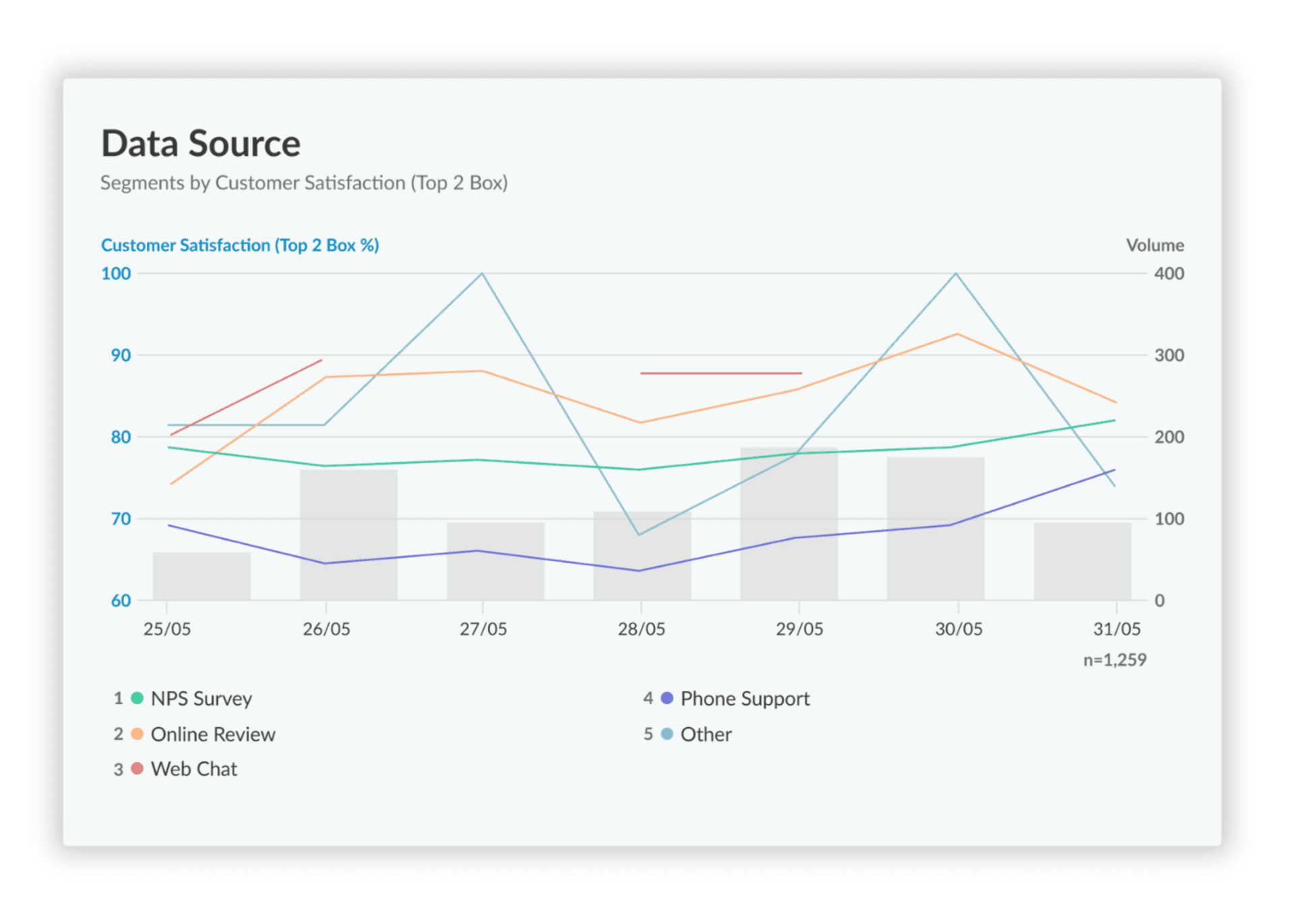Every week, customer experience leaders face the same frustrating reality: satisfaction scores drop, churn increases, and support tickets pile up. But the reasons why remain buried in thousands of unanalyzed customer conversations.
What if you could spot problems before they became crises? Companies leveraging contact center intelligence report 23% higher customer retention rates and reduce operational costs by up to 35%.
The difference isn't better luck or bigger budgets. It's transforming every customer conversation into strategic business intelligence.

What is Contact Center Intelligence?
Contact center intelligence is the systematic analysis of customer interactions across all channels to extract actionable insights that drive business decisions. Unlike traditional call monitoring that samples a tiny fraction of conversations, modern contact center intelligence uses artificial intelligence and natural language processing, integrating advanced AI tools such as machine learning and predictive analytics to analyze 100% of customer conversations in real-time.
Every email, chat, phone call, and social media interaction becomes a data point that helps you understand not just what customers are saying, but what they really mean. Contact center intelligence helps organizations understand and meet evolving customer expectations by analyzing customer data and personalizing interactions.
Many people confuse contact center intelligence with basic call recording or quality monitoring. Traditional quality assurance programs typically review 1-3% of calls manually. Contact center intelligence analyzes every single interaction automatically, providing comprehensive insights rather than spotty samples. These systems also support contact center agents by automating routine tasks and providing real-time insights to enhance productivity and service quality.
Why This Matters for CX Leaders
Your success gets measured on metrics like Customer Lifetime Value (CLV), Net Promoter Score (NPS), and Customer Satisfaction (CSAT).
Contact center intelligence directly impacts these KPIs by:
Identifying churn risks before they hit yourretention metrics
Revealing the specific drivers behind CSAT scores
Uncovering upsell opportunities that increase CLV
Providing real-time feedback on customer experience initiatives
Enhancing agent efficiency by reducing handling time and improving productivity
Contact center intelligence enables organizations to better serve customers through more efficient and personalized service, meeting and exceeding customer expectations.
Benefits of Contact Center Intelligence
Imagine walking into your office knowing exactly which customers need attention today, which product features are causing the most frustration, and which agents are delivering exceptional experiences. That’s the reality contact center intelligence creates.
By automating processes and reducing errors, contact center intelligence drives business efficiency across customer service, sales, and marketing functions. Here are some key benefits we see for teams who embrace it:
Proactive Issue Detection
Instead of discovering problems after they've affected hundreds of customers, contact center intelligence spots emerging issues in real-time. When a new software update starts generating confusion, you'll know within hours, not weeks.
Enhanced Agent Performance
Traditional quality assurance reviews 2-3 calls per agent monthly. Contact center intelligence analyzes every interaction, providing continuous feedback. With agent assist features, agents receive real-time guidance and deliver real-time assistance during customer interactions, helping them respond more effectively and efficiently. Agents receive specific coaching on empathy, problem-solving, and product knowledge based on actual performance data rather than random sampling.
Improved Customer Satisfaction
When agents have real-time access to customer sentiment and conversation history, they can personalize each interaction. AI-driven tools such as intelligent call routing and sentiment analysis increase customer satisfaction by providing more personalized and efficient service. They know if a customer called three times about the same issue. They understand the emotional context before picking up the phone.
Intelligent routing and AI-powered solutions improve customer satisfaction by reducing call handling times and delivering more personalized experiences. The result? Customers feel heard and understood, leading to higher satisfaction and stronger loyalty. These improvements ultimately increase customer loyalty.
Operational Efficiency
Contact center intelligence automates routine tasks that previously consumed hours of manual work, such as data entry and call routing. Instead of analysts spending days categorizing feedback themes, AI identifies patterns instantly. Workforce management becomes predictive rather than reactive, as advanced virtual agents and predictive analytics are used to improve operational efficiency.
Strategic Decision Making
Perhaps most importantly for CX leaders, contact center intelligence transforms customer feedback into boardroom-ready insights. By analyzing contact center data, you can identify customer trends and use these insights to inform strategic decisions. You can prove the ROI of customer experience investments with concrete data. When you propose a budget for agent training or process improvements, you have the conversation data to back up your recommendations.
Common Use Cases for Contact Center Intelligence
Smart organizations use contact center intelligence to solve specific business challenges. By leveraging advanced analytics, they can monitor and analyze customer journeys across multiple channels, gaining valuable insights into each stage of the customer lifecycle. These insights empower organizations to deliver personalized solutions that address individual customer needs and enhance overall customer experience.
Here are the most impactful applications:
Churn Prevention and Customer Retention
Contact center intelligence identifies at-risk customers through conversation patterns, sentiment shifts, and escalation triggers. The system flags customers showing early warning signs: multiple contacts about the same issue, declining sentiment scores, or mentions of competitive research.
Proactive retention efforts supported by contact center intelligence not only reduce churn but also help build long-term customer loyalty.
Product Development and Innovation
Customer conversations contain goldmine of product feedback. Contact center intelligence automatically categorizes feature requests, identifies common pain points, and tracks satisfaction levels for different product lines.
Compliance and Risk Management
For regulated industries, contact center intelligence ensures consistent adherence to compliance requirements. The system monitors conversations for required disclosures, appropriate language, and regulatory compliance in real-time.
Agent Training and Development
Rather than generic training programs, contact center intelligence enables personalized agent development. The system identifies specific skill gaps for individual agents: does Sarah need improvement on empathy? Does Mike struggle with technical explanations?
Customer Journey Optimization
Contact center intelligence maps customer conversations to journey stages, revealing friction points across the entire experience. By leveraging customer history and analyzing historical data, organizations can identify where customers get confused during onboarding, what causes billing inquiries, or why certain segments contact support more frequently.
How Contact Center Intelligence Works
Contact center intelligence combines several technologies to transform raw customer conversations into actionable business insights. Contact center AI leverages automation, predictive analytics, and omnichannel integration to transform customer service, enhancing agent productivity and operational efficiency.
Here’s how the process works:
1. Data Collection and Integration
The system captures interactions from multiple channels: phone calls, emails, chat sessions, social media messages, and even video calls. Advanced platforms integrate with existing contact center solutions to ensure comprehensive data collection.
Cloud-based services make this integration seamless, pulling conversation data in real-time without disrupting existing workflows. Platforms like Kapiche provide scalable, cloud-based infrastructure for data integration and analytics, supporting advanced features such as AI-driven insights and real-time analytics.
2. Natural Language Processing and Analysis
Once collected, conversations undergo sophisticated natural language processing. The system doesn’t just identify keywords but understands context, intent, and emotional undertones. It can distinguish between a customer saying “fine” sarcastically, versus genuinely expressing satisfaction.
Additionally, text-to-speech technology is used to convert written text into natural-sounding speech, enabling customer service applications to deliver AI-powered responses in a human-like voice.
Machine learning algorithms continuously improve this analysis, learning from your specific customer language patterns and industry terminology.
3. Real-Time Analytics and Insights
As conversations happen, the system generates immediate insights. It identifies customer sentiment, categorizes inquiry types, measures agent performance, and flags potential issues for immediate attention.
Dashboards update in real-time, giving contact center leaders instant visibility into operations and customer experience metrics.
4. Predictive Analytics and Alerting
Advanced contact center intelligence goes beyond describing what happened, to predicting what will happen. The system identifies patterns that typically precede customer churn, agent turnover, or service escalations. By analyzing customer behavior, predictive analytics can forecast demand and identify potential issues before they escalate.
Automated alerts notify managers when situations require immediate intervention, enabling proactive rather than reactive management.
5. Integration and Action
The most sophisticated platforms integrate insights directly into agent workflows and business systems. CRM records update automatically with conversation summaries. Workforce management systems adjust staffing based on predicted call volumes. Marketing teams receive real-time feedback on campaign effectiveness.
Transform Your Customer Conversations into Strategic Intelligence with Kapiche
The VoC 2.0 Advantage
While traditional Voice of Customer programs rely on surveys with low response rates and delayed insights, Kapiche pioneered VoC 2.0: analyzing 100% of customer conversations in real-time.

Key Kapiche Capabilities:
AI-Powered Auto Themes: Automatically identify conversation topics without manual setup
Cross-Channel Analysis: Unified insights across email, chat, voice, and social interactions
Predictive Outcome Modeling: Identify churn risk and satisfaction drivers before they impact metrics
Real-Time Analytics: Spot emerging issues as they happen, not weeks later
Journey Segment Enrichment: Map conversations to specific customer lifecycle stages







